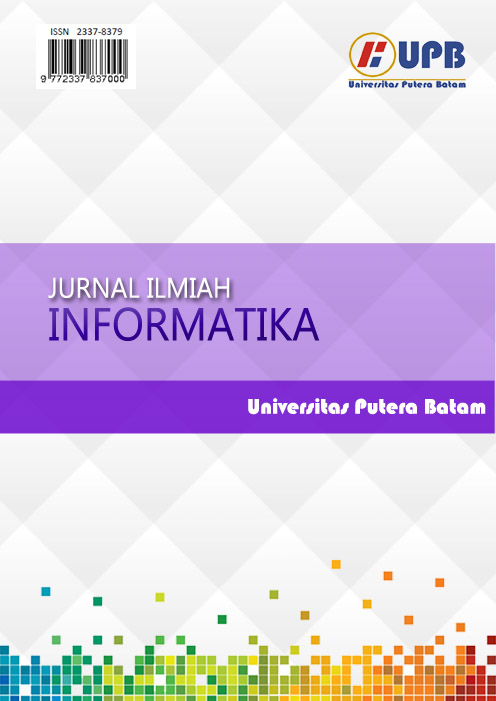ANALISIS PENGGUNAAN APLIKASI NIMBUS BM PADA ABSENSI KARYAWAN KEMENPAREKRAF RI BERBASIS ANDROID MENGGUNAKAN METODE TAM
DOI:
https://doi.org/10.33884/jif.v13i01.9434Keywords:
Analisis, Aplikasi, Absensi Karyawan, chnology Acceptance Model (TAM)Abstract
This study discusses the Nimbus BM application as an Android-based employee attendance solution at the Indonesian Ministry of Tourism and Creative Economy. Attendance is the process of recording the presence and return of individuals in activities, which is important in managing attendance. However, the Nimbus BM application sometimes experiences errors when employees check in and out, especially when the network is unstable, resulting in inaccurate time recording. The simple features of this application are also considered less supportive of optimal attendance needs. This study uses the Technology Acceptance Model (TAM) approach to measure employee acceptance and identify aspects that need to be improved, through four main variables: perceived ease of use, perceived usefulness, attitude towards use, and intention to use. The results of the analysis show that the Nimbus BM application received an average score of 85.09% for all variables, indicating that this application is accepted by the majority of employees. This study is expected to be the basis for further development of the Nimbus BM application, especially in improving features and network stability to be more optimal in meeting employee attendance needs effectively at the Indonesian Ministry of Tourism and Creative Economy.
References
I Gusti Agung Made Yoga Mahaputra, Ida Bagus Alit Swamadika, and Rukmi Sari Hartati, “Analisis penerimaan aplikasi hadir sebagai media absensi pada PT. baliyoni saguna menggunakan technology acceptance model,” Majalah Ilmiah Teknologi Elektro, vol. 21, no. 2, p. 309, Dec. 2022, doi: 10.24843/mite.2022.v21i02.p20.
Christian Jody Toha and Mulyati Mulyati, “Analisis technology acceptance model (TAM) pada aplikasi greatday,” Jurnal Ilmu Komputer, vol. 3, no. 2, Sep. 2022, doi: https://doi.org/10.56869/klik.v3i2.381.
Muh. Nurtanzis Sutoyo and Anjar Pradipta, “Analysis of the technology acceptance model (TAM) for SIMKREASI users at USN kolaka,” Formosa Journal of Sustainable Research, vol. 2, no. 1, pp. 25–36, Jan. 2023, doi: 10.55927/fjsr.v2i1.2604.
Muhammad Deva Juniar and Muhammad Muharrom, “Pengaruh efektifitas aplikasi HRMS terhadap absensi karyawan pada PT. thai seng indonesia menggunakan metode TAM,” Jurnal Sistem Informasi dan Teknologi Informasi Komputer, vol. 2, no. 1, Nov. 2023, doi: https://doi.org/10.53624/jsitik.v2i1.283.
Fira Aulia Nadia and Adinda Tria Suci, “Analisis kemudahan user dalam menggunakan aplikasi ‘hadir’ dengan metode TAM,” TIN: Terapan Informatika Nusantara, vol. 3, no. 9, pp. 378–383, Feb. 2023, doi: https://doi.org/10.47065/tin.v3i9.4150.
Kersna Minan, “Analisis pendekatan metode TAM pada penggunaanaplikasi e-commerce,” Ekonomi, Keuangan, Investasi dan Syariah (EKUITAS), vol. 3, no. 1, pp. 181–187, Nov. 2021, doi: https://doi.org/10.47065/ekuitas.v3i2.1118.
Nanda Kharisma, Susanto Susanto, and Nur Nawaningtyas Pusparini, “Analisa Kinerja karyawan bagian penjualan produk electrical dan mechanical dengan metode SWOT,” Router : Jurnal Teknik Informatika dan Terapan, vol. 2, no. 3, pp. 212–219, Aug. 2024, doi: 10.62951/router.v2i3.173.
Arina Nur Syahputri and Dimas Aryo Anggoro, “Penerapan sistem informasi penjualan dengan platform e-commerce pada perusahaan daerah apotek sari husada demak,” Science and Information Technology (SINTECH), vol. 3, pp. 58–69, Apr. 2020, doi: https://doi.org/10.31598/sintechjournal.v3i1.540.
I Gusti Agung Made Yoga Mahaputra, Ida Bagus Alit Swamadika, and Rukmi Sari Hartati, “Analisis penerimaan aplikasi hadir sebagai media absensi pada PT. baliyoni saguna menggunakan technology acceptance model,” Majalah Ilmiah Teknologi Elektro, vol. 21, no. 2, p. 309, Dec. 2022, doi: 10.24843/mite.2022.v21i02.p20.
[Mulia Rahmayu amasI rmalasari, “Bulletin of information technology (BIT) analisis penerimaan sistem presensi karyawan berbasis fingerprint dengan metode technology acceptence pada PT. karex indo express,” Bulletin of Information Technology (BIT), vol. 3, no. 4, pp. 261–267, Sep. 2022, doi: https://doi.org/10.47065/bit.v3i4.374.
Firdan Febrian and Asrul Sani, “Analisa sistem pendukung keputusan pemilihan karyawan terbaik dengan metode simple additive weighting (SAW) pada PT. karlin mastrindo,” Jurnal Multidisiplin Saintek, vol. 1, no. 8, pp. 21–31, Nov. 2023, [Online]. Available: https://ejournal.warunayama.org/kohesi.
Okta Fitria Anggraeni and Fia Rahma, “Pengaruh kualitas pelayanan, kualitas produk, dan harga terhadap loyalitas pelanggan pada toko ridho (grosir sembako) di desa sukosewu,gandusari,” Journal Of Social Science Research, vol. 3, pp. 3140–3154, Jul. 2023, Accessed: Oct. 29, 2024. [Online]. Available: https://j-innovative.org/index.php/Innovative/article/view/2127.
Yayan Ashari, Hendra Supendar, and Riza Fahlapi, “Analisis kepuasan pengguna terhadap penerapan aplikasi my XL dengan metode techhnology acceptance model,” Jurnal Komputer Antartika, vol. 2, pp. 80–87, Jun. 2024, doi: https://doi.org/10.70052/jka.v2i2.98.
Aditya Nurul Rohman, Moh Mukhsin, and Gerry Ganika, “Penggunaan Technology acceptance model dalam analisis actual use penggunaan e-commerce tokopedia indonesia use of the technology acceptance model in analyzing actual use of e-commerce tokopedia indonesia,” May 2023. doi: https://doi.org/10.58222/jemakbd.v2i1.150.
Asrul Sani, Nur Nawaninatyas P, Rizal, Yenni Khristiana, Achmad Udin Zailani, and T. Husain, “E-business Adoption Models in Organizational contexts on the TAMextended model: a preliminary assessment,” in 2020 8th International Conference on Cyber and IT Service Management, CITSM 2020, Institute of Electrical and Electronics Engineers Inc., Oct. 2020. doi: 10.1109/CITSM50537.2020.9268869.
Mulia Rahmayu and Imas Irmalasari, “Bulletin of Information Technology (BIT) Analisis Penerimaan Sistem presensi karyawan berbasis fingerprint dengan metode technology acceptence pada PT. karex indo express,” Bulletin of Information Technology (BIT), vol. 3, no. 4, pp. 261–267, Sep. 2022, doi: https://doi.org/10.47065/bit.v3i4.374.
Asrul Sani, Binan Addarda, Nur Nawaningtyas Pusparini, Mochamad Sofyan, and Agus Budiyantara, “Perbandingan metode TAM dengan SPSS terhadap tingkat penerimaan aplikasi e-perpustakaan bagi siswa,” Journal of Technology Information, vol. 10, no. 1, pp. 145–152, Jun. 2024, doi: 10.37365/jti.v10i1.272.
Rafi Irbah Kusumawati and Brady Rikumahu, “Penggunaan technology acceptance model (TAM) dalam analisa niat perilaku penggunaan internet banking pada mahasiswa universitas telkom,” Jurnal Mitra Manajemen (JMM Online), vol. 1, no. 2, pp. 215–229, Feb. 2019, doi: https://doi.org/10.52160/ejmm.v3i2.203.
Muhammad Andre, Nita Rosa Damayanti, Andri, and Taqrim Ibadi, “Analisa perbandingan metode TAM dan UTAUT terhadap tingkat penerimaan pengguna aplikasi easy access,” vol. 6, no. 1, pp. 251–261, Sep. 2024, doi: https://doi.org/10.47065/josh.v6i1.5964.
Downloads
Published
How to Cite
Issue
Section
License
Copyright (c) 2025 JURNAL ILMIAH INFORMATIKA

This work is licensed under a Creative Commons Attribution 4.0 International License.






















